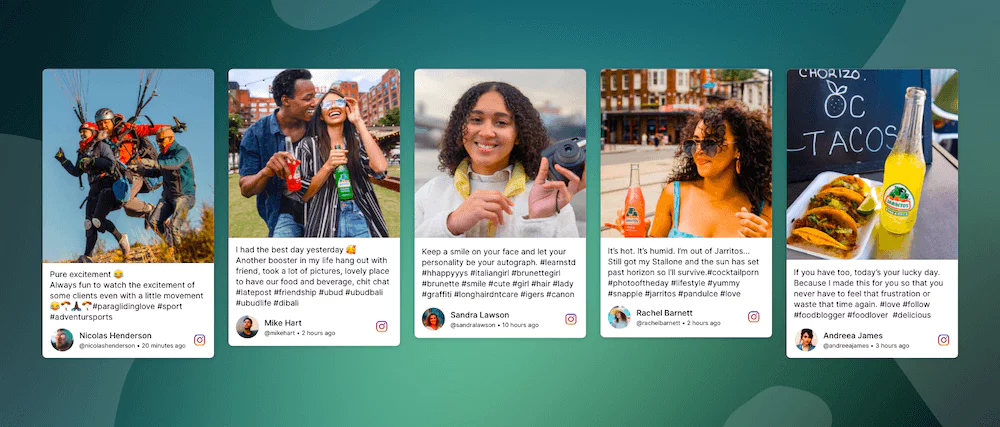
In today’s fast-paced digital landscape, where consumers are bombarded with marketing messages from every angle, brands face the challenge of standing out and fostering genuine connections with their audience. One of the most effective strategies to achieve this is through User-Generated Content (UGC) campaigns. UGC not only enhances brand authenticity but also builds trust and cultivates loyal customer communities. This blog post will explore how to leverage UGC campaigns to build brand loyalty, drawing on successful examples, strategies, and the role of services like Sociobo in enhancing your brand’s social presence.
Understanding User-Generated Content (UGC)
User-generated content refers to any form of content—be it images, videos, reviews, or social media posts—that is created by consumers rather than brands. This content serves as a powerful form of social proof, showcasing real customer experiences and interactions with a brand. In an age where consumers crave authenticity and relatability, UGC has emerged as a vital tool for brands looking to foster loyalty.

The Psychology Behind UGC and Brand Loyalty
At the heart of UGC’s effectiveness lies the psychological concept of social proof, introduced by Dr. Robert Cialdini in his book “Influence.” Social proof is the tendency of individuals to look to others for guidance in uncertain situations. When consumers see their peers engaging with a brand—whether through sharing photos, leaving reviews, or participating in campaigns—they are more likely to trust that brand and feel a sense of belonging to a community.
Why UGC Matters for Brand Loyalty
- Authenticity: UGC provides a genuine representation of a brand, as it reflects real customer experiences. This authenticity resonates with potential customers, building trust and credibility.
- Community Building: UGC fosters a sense of belonging among customers. When brands actively encourage and showcase customer contributions, they create a community of loyal advocates who feel valued.
- Increased Engagement: UGC campaigns often lead to higher engagement rates. When customers see their content featured by a brand, they are more likely to share it further, amplifying the brand’s reach.
- Cost-Effective Marketing: UGC is a cost-effective way to generate content. Brands can leverage customer contributions instead of investing heavily in traditional advertising.
Successful UGC Campaigns: Learning from the Best
To understand how to effectively implement UGC campaigns, let’s take a look at some successful examples that have significantly boosted brand loyalty.

- Coca-Cola’s #ShareACoke Campaign: One of the most iconic UGC campaigns, Coca-Cola’s #ShareACoke, encouraged customers to find bottles with their names on them and share photos on social media. This personalized approach not only led to increased sales but also generated millions of social media impressions. By tapping into the emotional connection consumers have with their names, Coca-Cola created a sense of belonging and community around its brand.
- Calvin Klein’s #MyCalvins Campaign: Calvin Klein’s #MyCalvins campaign featured celebrities and influencers sharing photos in their iconic underwear. This campaign not only increased brand visibility but also encouraged customers to share their own photos, creating a sense of community. By leveraging the influence of celebrities while simultaneously engaging everyday customers, Calvin Klein successfully fostered brand loyalty.
- Audi’s #WantAnR8 Campaign: Audi showcased the effectiveness of listening to customer desires through its #WantAnR8 campaign. When a fan tweeted about wanting to drive an Audi R8, the brand responded by allowing her to experience it for a day. This not only generated significant engagement but also created positive brand sentiment, demonstrating that Audi values its customers’ opinions.
- Lay’s #DoUsAFlavour Campaign: Lay’s #DoUsAFlavour campaign invited customers to suggest and vote on new chip flavors, offering a prize for the winning flavor. This interactive approach not only generated buzz but also provided valuable market research for the company. By involving customers in the product development process, Lay’s created a sense of ownership and loyalty among its audience.
Strategies for Implementing UGC Campaigns
To create a successful UGC campaign, consider the following strategies:

- Develop a Branded Hashtag: A memorable and relevant branded hashtag is essential for encouraging participation. Ensure that the hashtag is easy to remember and directly related to your brand. For example, Coca-Cola’s #ShareACoke effectively encapsulated the campaign’s essence.
- Offer Incentives for Participation: Encourage customers to participate by offering incentives such as prizes, discounts, or the chance to be featured on your brand’s social media channels. This not only motivates participation but also enhances the sense of community.
- Engage with Participants: Show appreciation for customer contributions by engaging with them. Like, share, and comment on their posts to encourage further participation. This interaction fosters a sense of connection and loyalty among your audience.
- Cross-Platform Promotion: Promote your UGC campaign across multiple platforms to maximize reach. Share customer content on your website, social media, and email marketing campaigns to create a cohesive brand experience.
- Monitor and Respond to Feedback: Keep an eye on the campaign’s progress and be ready to address any issues that arise. Responding to both positive and negative feedback demonstrates that you value customer opinions and are committed to improving their experience.
Incorporating UGC on Your Website
In addition to social media, incorporating UGC on your website can significantly enhance engagement and build trust. Here are some effective methods:

- Curated Feeds of Customer Content: Display a curated feed of customer photos or videos on your homepage. This visual showcase not only adds dynamism to your site but also allows potential customers to see products in real-life contexts. For instance, a clothing brand might feature a gallery of customers wearing their products, providing social proof and inspiration for new visitors.
- Customer Testimonials and Reviews: Integrate customer testimonials or reviews directly into your homepage design. Highlighting positive feedback can give visitors immediate insight into the experiences of satisfied customers. This strategy is particularly effective for service-based businesses or products that require a higher level of trust before purchase.
- UGC-Driven Statistics: Incorporating UGC-driven statistics can be impactful. Displaying the number of satisfied customers or the average rating of products can provide quick, persuasive social proof. These metrics can be updated in real-time to reflect the most current customer sentiment.
- Calls-to-Action for UGC Creation: Encourage ongoing UGC creation by featuring a call-to-action on your homepage that invites visitors to share their own content. This could be in the form of a branded hashtag campaign or a direct upload feature. By making it easy for customers to contribute, brands can ensure a steady stream of fresh UGC to feature.
- Legal Considerations: It’s important to obtain proper permissions and give credit to content creators when featuring UGC on your website. This ensures legal compliance and fosters goodwill among contributors. Many brands use UGC platforms or tools to manage this process efficiently and ethically.
The Role of Customer Reviews as Social Proof
Customer reviews are a cornerstone of social proof in the digital age, significantly influencing consumer behavior and shaping brand reputations. As a form of UGC, reviews provide potential customers with authentic insights into product quality and service experiences, helping to build trust and drive purchasing decisions.

Maximizing the Impact of Customer Reviews
To leverage customer reviews effectively, businesses should:
- Encourage Reviews: Actively request customers to leave reviews after purchases. This can be done through follow-up emails or during the checkout process.
- Display Reviews Prominently: Ensure reviews are easily accessible on product pages and throughout the website. Highlighting star ratings and review counts can enhance credibility.
- Engage with Reviews: Respond to both positive and negative reviews to demonstrate engagement and customer care. This shows that you value customer feedback and are committed to improving their experience.
- Utilize Reviews in Marketing: Incorporate customer feedback into marketing materials and social media posts. This can include sharing top reviews or testimonials on landing pages.
- Creating a Virtuous Cycle of Reviews: By effectively utilizing customer reviews as social proof, businesses can create a virtuous cycle where positive experiences lead to more reviews, which in turn attract more customers and generate more positive experiences. This approach not only enhances trust but also contributes to building a loyal customer base and a strong brand reputation in the competitive digital marketplace.
How Sociobo Can Help
As brands look to implement UGC campaigns and enhance their social media presence, services like Sociobo can play a crucial role. By leveraging the concept of social proof aggregation, Sociobo helps businesses systematically enhance their visibility, authority, and influence on social media platforms.

Sociobo offers growth services that provide aggregated followers and engagement, which can significantly boost a brand’s perceived credibility. This, in turn, attracts genuine followers and improves overall social media performance. By utilizing Sociobo’s services, brands can focus on creating engaging UGC campaigns while ensuring their social media profiles are optimized for maximum reach and engagement.
In an era where authenticity and connection are paramount, UGC campaigns present a powerful opportunity for brands to build loyalty and foster genuine relationships with their customers. By leveraging real customer experiences, brands can create engaging marketing strategies that resonate with audiences and drive brand loyalty.
As you embark on your journey to implement UGC campaigns, consider the strategies and examples discussed in this post. And remember, with the right tools and services like Sociobo, you can enhance your social media presence and cultivate a loyal customer community that champions your brand.
If you’re ready to take your brand’s social media strategy to the next level, explore the services offered by Sociobo. With their expertise in social proof aggregation, you can build a strong online presence that attracts genuine engagement and fosters lasting brand loyalty. Visit Sociobo.com today to learn more about how they can help you achieve your social media goals!






No comment yet, add your voice below!